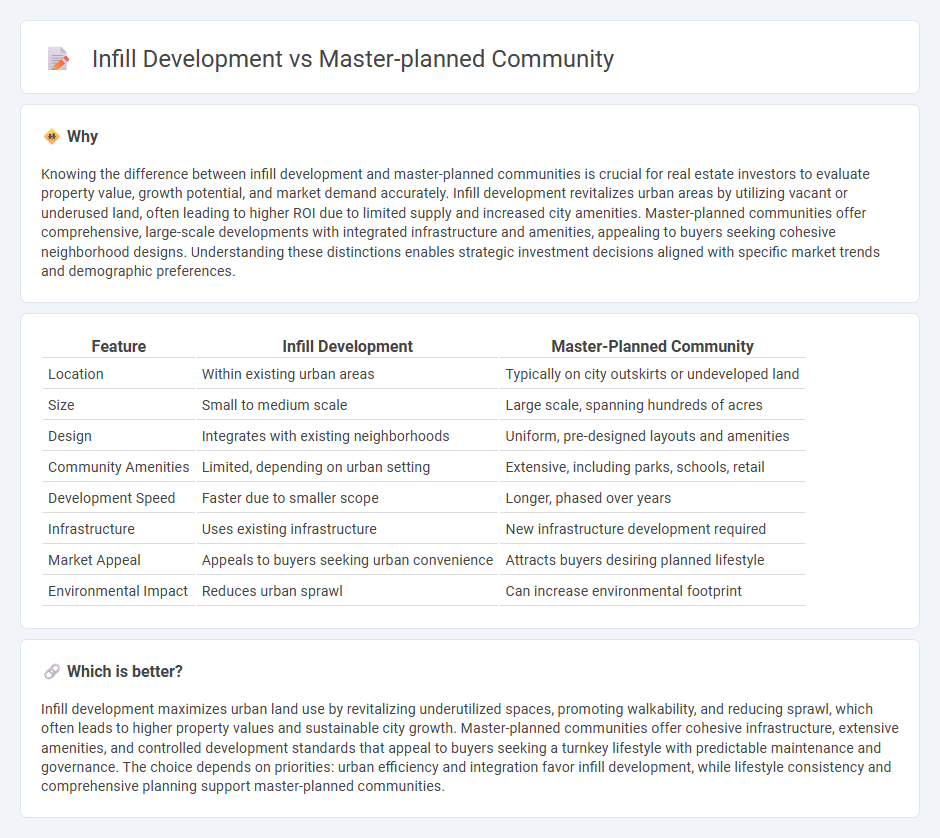
Infill development focuses on utilizing vacant or underused urban land to create compact, walkable neighborhoods that enhance existing infrastructure and promote sustainable growth. Master-planned communities are large-scale developments designed with comprehensive amenities, infrastructure, and zoning regulations to provide a cohesive and self-sufficient living environment. Discover how these two residential development approaches impact urban growth and lifestyle choices.
Why it is important
Knowing the difference between infill development and master-planned communities is crucial for real estate investors to evaluate property value, growth potential, and market demand accurately. Infill development revitalizes urban areas by utilizing vacant or underused land, often leading to higher ROI due to limited supply and increased city amenities. Master-planned communities offer comprehensive, large-scale developments with integrated infrastructure and amenities, appealing to buyers seeking cohesive neighborhood designs. Understanding these distinctions enables strategic investment decisions aligned with specific market trends and demographic preferences.
Comparison Table
| Feature | Infill Development | Master-Planned Community |
|---|---|---|
| Location | Within existing urban areas | Typically on city outskirts or undeveloped land |
| Size | Small to medium scale | Large scale, spanning hundreds of acres |
| Design | Integrates with existing neighborhoods | Uniform, pre-designed layouts and amenities |
| Community Amenities | Limited, depending on urban setting | Extensive, including parks, schools, retail |
| Development Speed | Faster due to smaller scope | Longer, phased over years |
| Infrastructure | Uses existing infrastructure | New infrastructure development required |
| Market Appeal | Appeals to buyers seeking urban convenience | Attracts buyers desiring planned lifestyle |
| Environmental Impact | Reduces urban sprawl | Can increase environmental footprint |
Which is better?
Infill development maximizes urban land use by revitalizing underutilized spaces, promoting walkability, and reducing sprawl, which often leads to higher property values and sustainable city growth. Master-planned communities offer cohesive infrastructure, extensive amenities, and controlled development standards that appeal to buyers seeking a turnkey lifestyle with predictable maintenance and governance. The choice depends on priorities: urban efficiency and integration favor infill development, while lifestyle consistency and comprehensive planning support master-planned communities.
Connection
Infill development and master-planned communities are connected through their shared goal of maximizing land use efficiency within urban areas. Infill development focuses on utilizing underused parcels in existing neighborhoods, while master-planned communities integrate these developments into cohesive, strategically designed environments with infrastructure, amenities, and zoning regulations. Together, they promote sustainable growth, reduce urban sprawl, and enhance community connectivity.
Key Terms
Zoning
Master-planned communities feature comprehensive zoning that integrates residential, commercial, and recreational spaces for cohesive urban living. Infill development focuses on maximizing underutilized parcels within existing zoning frameworks to promote sustainable growth and reduce urban sprawl. Explore zoning strategies to understand the distinct planning benefits of each approach.
Density
Master-planned communities often emphasize medium to low density with carefully designed residential zones, open spaces, and amenities, promoting a balanced urban environment. Infill development targets higher density by utilizing underused or vacant land within existing urban areas, optimizing space efficiency and reducing urban sprawl. Explore the impact of density on urban planning by learning more about these development strategies.
Infrastructure
Master-planned communities feature comprehensive infrastructure designed from inception, including roads, utilities, schools, and recreational facilities, ensuring cohesive development and efficient resource management. Infill development relies on upgrading or integrating into existing infrastructure, often facing challenges such as limited space and older utility systems requiring modernization. Explore deeper insights into infrastructure strategies and benefits for both master-planned communities and infill development projects.
Source and External Links
What Is A Master-Planned Community? All You Need To Know - A master-planned community (MPC) is a large-scale residential development carefully designed to integrate housing, commercial spaces, recreational facilities, green spaces, and various amenities into a cohesive, self-sufficient environment focusing on convenience, security, and lifestyle quality.
Planned community - Wikipedia - A planned community is any settlement that is carefully designed and constructed from its inception, often on previously undeveloped land, contrasting with organically evolved settlements and including examples such as planned capitals and cities worldwide.
Master Planned Living - Northern CA New Homes - Master-planned communities offer varied home styles alongside amenities like schools, parks, shopping, and recreational facilities, providing convenience and a strong sense of community, as exemplified by developments in Northern California.
 dowidth.com
dowidth.com